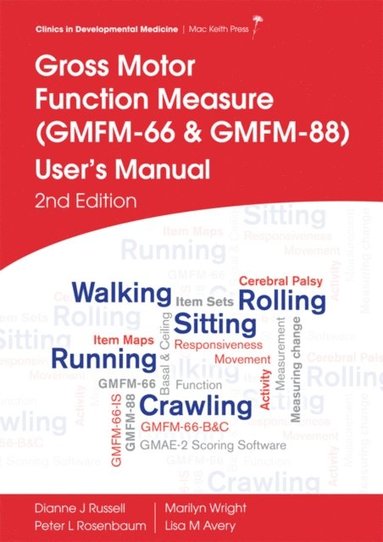
- Format
- Häftad (Paperback / softback)
- Språk
- Engelska
- Antal sidor
- 304
- Utgivningsdatum
- 2013-11-08
- Upplaga
- 2nd Edition
- Förlag
- Mac Keith Press
- Illustrationer
- illustrations
- Dimensioner
- 238 x 185 x 25 mm
- Vikt
- Antal komponenter
- 1
- Komponenter
- Contains 1 Spiral bound
- ISBN
- 9781908316882
- 660 g
Gross Motor Function Measure (GMFM-66 and GMFM-88) User's Manual
Kundrecensioner
Fler böcker av författarna
-
Cerebral Palsy
Peter L Rosenbaum, Lewis Rosenbloom, Peter Rosenbaum
-
Gross Motor Function Measure (GMFM-66 & GMFM-88) User's Manual
Dianne J Russell, Marilyn Wright, Peter L Rosenbaum, Lisa M Avery, Dianne J Russell
-
Life Quality Outcomes in Children and Young People with Neurological and Developmental Conditions
Gabriel M Ronen, Peter L Rosenbaum, Gabriel M Ronen, Peter L Rosenbaum
-
Ethics in Child Health
Peter L Rosenbaum, Gabriel M Ronen, Bernard Dan, Jennifer Johannesen, Eric Racine
Övrig information
Dianne J. Russell is Research and Knowledge Exchange Specialist with CanChild Centre for Childhood Disability Research. She has been a health services researcher for over 20 years and a key individual in the development, evaluation and dissemination of clinical outcome measures such as the Gross Motor Function Measure (GMFM). Her current focus is on facilitating the use of research evidence in practice by engaging with research users throughout the research process and by making research results easily accessible in multiple formats to families, service providers, and policy decision-makers. Peter L. Rosenbaum is a Developmental Paediatrician, health services research, teacher, writer and editor. His career has been devoted to childhood disability, and all his roles have involved work with, or about, children with impairments and their families. He has held over 75 research grants and has contributed to almost 300 peer-reviewed papers, book chapters, editorials and invited commentaries in his field. Marilyn Wright is a pediatric physiotherapist. She has worked with children with physical disabilities or cancer in acute, rehabilitation, and community settings. In addition to clinical work, she has been involved in research, teaching, administrative, and policy roles. Work in these areas has contributed to inter-professional and multi-site best practice initiatives. Current interests include physical activity promotion, lifespan services, and motion analysis. Lisa M. Avery is an independent statistician and founder of Avery Information Services. She provides statistical consulting and analysis services to various academic institutions and is primarily involved in pediatric disability research. Her primary interests are outcome measurement and causation modeling.
Innehållsförteckning
1. Overview of the Gross Motor Function Measure (GMFM) 2. Conceptual Background 3. Development and Validation of the GMFM-88 4. Development and Validation of the GMFM-66 5. GMFM-66: Two Short Forms of Administration 6. Administration and Scoring Guidelines for the GMFM-88 and GMFM-66 7. Interpretation and Uses of the GMFM-88 and GMFM-66 8. Applications of the GMFM: What Have We Learned and Where Can We Go Next?
